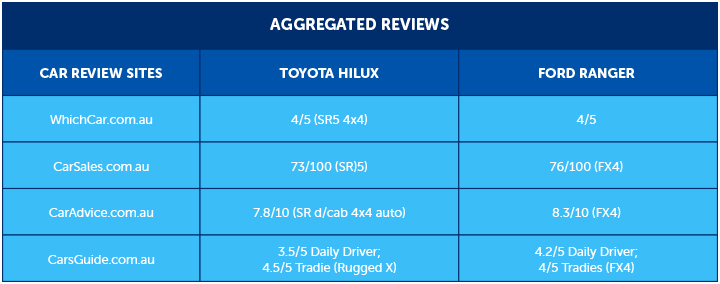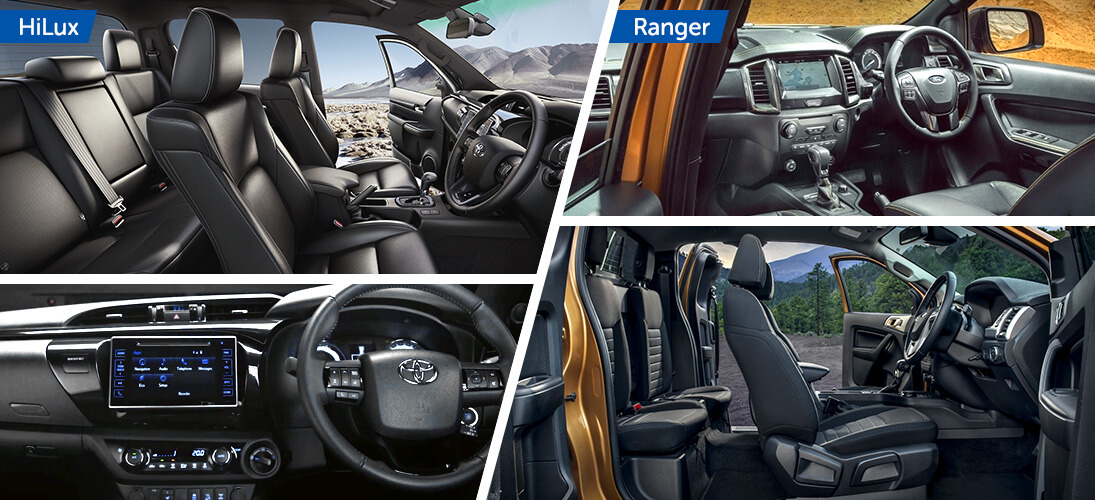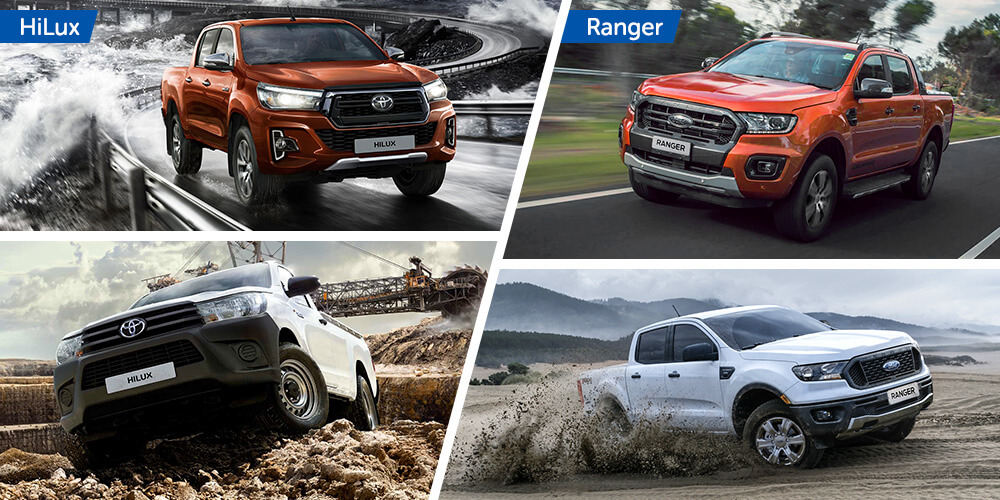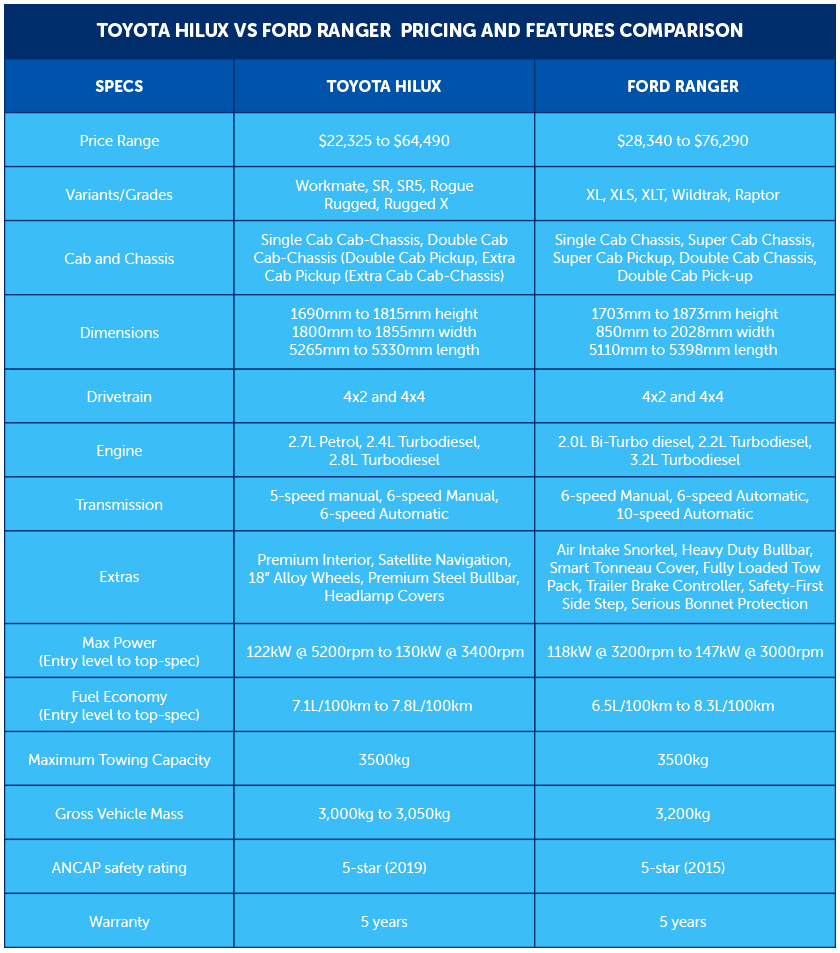Car Comparison Review: Toyota HiLux vs Ford Ranger
Toyota HiLux vs Ford Ranger: Which is the True King of the Utes?
Toyota HiLux and Ford Ranger are the two most popular and top-selling utes in Australia today. They are also engaged in a seemingly perpetual battle for ute supremacy for quite a long time. In fact, some car enthusiasts call their rivalry the new “Commodore vs Falcon" thing, with many ute fans falling into “Team Ranger” or “Team HiLux”.
How about we run through the specs, features, and other significant deets of the two pickup trucks?

Milestones
Toyota HiLux
- First ute to top the charts in Australian automotive history
- First ute to score five stars in the 2019 Australasian New Car Assessment Program (ANCAP) crash testing
- Ranked number one in top-selling vehicles for the last 4 consecutive years
- Top-selling 4x2 heavy-duty, body-on-frame ute since the year 2000 (Workmate)
- Best-selling 4x2 ute since 2006 (Workmate)
Ford Ranger
- Winner of the 2020 International Pick-up Award
- The 4x4 models have outsold HiLux 4x4s on 29 individual months since August 2015
- Outsold HiLux in the 4x4 category for eight months in a row in 2019
- Outsold the Toyota HiLux in the 4x4 category in the annual sales race in the past three years
- Outsold the Toyota HiLux in the 4x4 category for the first three months of 2020

Exterior
Style-wise, the Ranger looks more muscular and powerful with its more aggressive front-end design. The HiLux has also undergone minor exterior styling tweaks, like the new front grille and the LED lights on the front and rear end, but its appearance largely remains in between the car-like Ranger and the industrial-looking D-Max.
In terms of physical footprint, the Ford Ranger is a bigger unit. It is longer and wider than HiLux, and has a longer wheelbase. All these factors translate into a larger cabin. Because the Ranger is bigger and heavier than the HiLux, it also has a larger payload rating (970kg against 955kg).
While Ford’s bigger cabin provides more room for people, the HiLux offers more space for cargo because of its solid 15cm longer tray with a similar tub depth as that of the Ranger.
Verdict: The HiLux with its longer tray better serves the main purpose of a ute.

Interior
As mentioned above, the Ford Ranger has a bigger dimension which translates into a bigger and more spacious cabin for passengers, including those in the back. The seat base is comfortable and there’s great legroom for taller passengers. The armrest has cupholders and a handy 220-volt outlet. Unfortunately, there are no air vents.
The infotainment system is also great. The twin-screen instrument cluster is configurable and provides a multitude of information about the drive. The additional three USB points in front of the gear lever and in the rear-view mirror housing make dashcam installation easy.
However, the climate control system relies on the screen for feedback. The mirror control switch is not easily reachable because it is hidden behind the steering wheel. There is also no option to add heated seats.
On the Toyota HiLux, a more improved cabin features more hard plastic surfaces and a little design on the swept dashboard. While the cabin amenities do not provide as much comfort as that of a Ranger, they are functional. These include the user-friendly single-zone climate control, accessible 4WD mode select dial that can be changed without taking the eyes from the road, usable switchgear, and plenty of storage including a double glovebox.
However, the rear seat can be tight, especially for long-legged passengers. Good thing there are vents, requisite armrests, and windows that go all the way down. There’s no replacement for passenger displacement though.
Verdict: Ford Ranger has a more accommodating interior.

Infotainment and Connectivity
In terms of equipment, both utes have modern infotainment features, like satellite navigation, keyless entry, standard tow-hitch, rear differential lockers, sports bars, side steps, and several driver assistance and safety technologies.
The Ranger has dual-zone climate control and smartphone connectivity. The HiLux makes up for its lack of Apple CarPlay and Android Auto connectivity with standard-across-the-range adaptive cruise control, which is only an optional feature on the Ranger.
Toyota’s 7.0-inch touchscreen looks like a modern tablet, but its system is slow. Other “flaws” include the:
- Few station selections on the DAB radio tuner
- Motion lockout on the navigation software
- Touchpad buttons for volume that don’t work when the car is moving
By contrast, the Ranger’s 8.0-inch screen Sync 3 system is responsive and user-friendly.
- The native navigation software responds to free-form address entry
- The entertainment functions are simple to find.
- A smartphone can be plugged and use device projection for a seamless experience.
- The round volume and tuning knobs are easy to operate.
- Both sound systems run six-speakers and can function without too much trouble.
Driving wise, both utes have many convenience features such as the standard automatic LED headlamps, a rear-view camera, push-button start, autonomous emergency braking with pedestrian detection, lane departure alert, and speed sign recognition system. The HiLux doesn’t have parking sensors while the Ranger has them on the front and rear.
Verdict: The Ranger has more modern infotainment with better usability.

Performance
On-Road
Both Ford Ranger and Toyota HiLux are a common sight on Australia’s urban streets and freeway networks. They can also handle the ebb and flow of traffic well enough despite being big.
The HiLux is punchy off the line, but the lack of sensors and electric assistance on the steering rack can make it difficult to park. Driving without anything in the tray, the rear end also becomes unstable but it settles as soon a modest load is placed. Noise can also be heard when driving on the highway, especially under load. Nevertheless, the cloth seats absorb some of the sound and vibration. It is generally a comfortable tourer. The adaptive cruise control system also works well. When used with the speed sign recognition function, adapting to changing limits on the road is easy.
On the Ford Ranger, the comfort level is higher. The car comes with an active sound cancellation and an acoustic windscreen that makes the cabin quiet during the ride. Even with an empty tray, the rear end is also not as unstable as the HiLux. On a busy road, the Ranger is also easy to maneuver with its good visibility, advanced technology, and light steering.
Verdict: The Ford Ranger takes the lead.
Off-Road
Built for off-roading, both utes prove capable and reliable on changing frictional surfaces. As things get steeper, however, the difference can be observed.
The square-jawed Ranger with its 29-degree approach, 21-degree departure angles, and 237mm ground clearance needs more effort when driving through hills, valleys and steep rutted tracks when compared to the overbite HiLux with its 31-degree approach, 26-degree departure and 279mm ground clearance.
The Ranger’s low-range gearing throttle response is not as responsive as the HiLux.
Verdict: The HiLux wins this round.

Safety
The HiLux’s Toyota Safety Sense suite that comes standard on all ranges has brought a significant increase in standard safety gear. The suite includes auto emergency braking with pedestrian and cyclist detection, lane departure warning, road sign assist, and active cruise control. The car also has seven airbags, stability, brake and traction controls, a reversing camera, hill start assist, and two ISOFIX child-seat mounting points on the outer two rear seats and three top-tether points. However, it doesn’t have blind-spot monitoring, rear cross-traffic alert, and driver attention alert.
Meanwhile, all Ranger models have an auto emergency braking (AEB) with pedestrian detection, lane-keeping assist, driver attention alert, traffic sign recognition and automated high-beam lights, and adaptive cruise control. It also has six airbags, a reversing camera, front and rear parking sensors and a semi-autonomous parking system. There is, however, no blind-spot monitoring and rear cross-traffic alert.
Verdict: HiLux wins with its 2019 5-star ANCAP crash test rating versus Ranger's 5-star from 2015.

So, the HiLux or the Ranger?
It’s impossible to choose the rightful king of the ute between the two because they each have sets of advantages and shortcomings.
However, it is safe to say that the best ute depends on what the owner mainly intends to do with the vehicle. For tough works around the city and suburban neighbourhoods, the Ranger may prove more beneficial. For off-roading, however, the HiLux may be more reliable. Then again, every ute owner has a unique story—The value of the two cars really depends on one’s specific situation and driving environment.
Are you more of a HiLux dude or a Ford guy? Regardless of your preference, we can help find the right car loan to purchase your dream ute. Call 1300 722 210 now!
